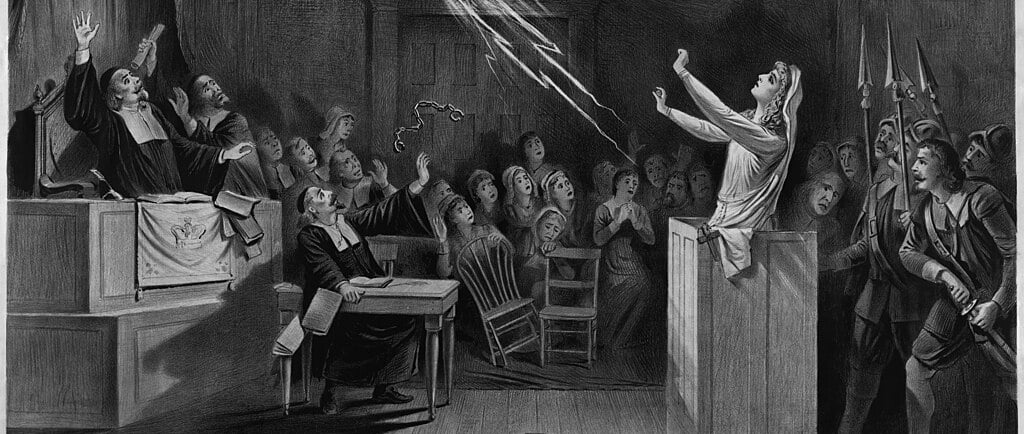Remembering the Salem Witch Trials
Blog post descriptionFew events in American history capture the imagination quite like the Salem Witch Trials of 1692. For more than three centuries, the story of Salem has fascinated historians, writers, and the public. The mix of fear, hysteria, and injustice has become a cultural touchstone, inspiring books, plays, films, and even annual festivals. Yet beneath the folklore and modern-day celebrations lies a darker truth: these were real people who endured false accusations, public trials, and ultimately, death.
- Aimee Rose-Haynes
10/25/20256 min read


Fear and Hysteria in Salem
The Salem Witch Trials took place in colonial Massachusetts during a time of deep religious fervor, political instability, and fear of the unknown. It began in Salem Village when a group of young girls claimed to be tormented by witches. Their fits, screams, and strange behaviors quickly captured the attention of ministers and leaders. Within weeks, accusations of witchcraft spread like wildfire, and suspicion fell on neighbors, friends, and even respected community members.
By the time the hysteria ended, more than 200 people were accused, and 20 were executed. Nineteen were hanged, and one man, Giles Corey, was pressed to death with stones for refusing to enter a plea. Dozens more were imprisoned under harsh conditions, with some dying while awaiting trial.
The Victims of Salem
The accused were not nameless figures from long ago. They were people with families, farms, trades, and daily lives that were suddenly interrupted by fear and suspicion.
Bridget Bishop was a midwife and the first person to be executed on June 10, 1692. She was known for her independence and her outspoken personality. Her reputation for challenging societal expectations made her an easy target. Prior history said she ran a tavern, but new research has suggested it was actually Sarah Bishop.
Sarah Good, executed on July 19, was a poor woman often seen begging for food and shelter. She was disliked by many in the community and her poverty made her especially vulnerable to accusation. She was the daughter of a wealthy tavern owner who took his own life when she was 17 years old. She married an indentured servant who died early into their marriage leaving behind a large debt.
Rebecca Nurse, executed on July 19, was a 71-year-old grandmother who had been deeply respected by her neighbors. Her death came as a shock to many and revealed how far the hysteria had spread. She was convicted and hanged in 1692. In 1706, her accuser Ann Putnam Jr. confessed and expressed remorse for the part she played in Rebecca’s death. Rebecca was fully exonerated after her death.
Giles Corey refused to plead guilty or not guilty to the charges brought against him, knowing that entering a plea would result in the seizure of his family’s land. To force a confession, he was pressed beneath heavy stones until he died. His last reported words were, “More weight.” Corey had a long history in the courts, mostly for petty theft, and he had pleaded guilty to such offenses in the years before the witchcraft accusations. As a large landowner and farmer in Salem, he employed indentured farm workers. He was once accused of murdering one of them, Jacob Goodall, by beating him with a stick after Goodall stole apples. Giles was not punished for the man’s death because corporal punishment was considered legal, but he was charged with using unreasonable force and fined.
Martha Corey, the wife of Giles Corey, was executed by hanging. Her attempts to defend both her husband and herself only fueled further suspicion and made her an even greater target. Martha was also judged harshly because of her son, Benoni, who was born out of wedlock and was of mixed race, possibly African or Native American. To the Puritan community, this was seen as evidence of sin and guilt, which added weight to the accusations against her.
George Burroughs, a former minister known for being strong willed, was accused of using supernatural powers. He had served as a minister in Salem Village, but the town failed to pay his wages. After his wife died in childbirth, he was forced to borrow money from John Putnam to cover her funeral expenses, a debt he was never able to repay. Burroughs later moved to Wells, Maine around 1688, but in 1692 he was accused of witchcraft, arrested in Wells, and brought back to Salem for trial. His accusers included Thomas Putnam and Jonathan Walcott, who were angered over the unpaid debt. At his execution, Burroughs recited the Lord’s Prayer flawlessly, something that many at the time believed a witch could not do. The crowd was deeply moved by his words, yet the execution was carried out despite their reaction.
Elizabeth Howe lived in Topsfield, MA. She was accused by a 10-year-old child and was put on trial and ultimately found guilty. She was executed July 19, 1692. Elizabeth was a farmer’s wife from Ipswich who had long faced suspicion from neighbors. She had been denied membership in a local church years earlier, which increased mistrust toward her.
Mary Eastey was accused of witchcraft and executed on September 22, 1692. She was later exonerated in 1711 along with several other victims, and her husband received compensation for her wrongful death. The Eastey family had a complicated relationship with the Putnam family, which likely contributed to her being targeted during the hysteria. Mary was the sister of Rebecca Nurse and, like her, was respected in the community. Before her execution, she wrote a powerful petition to the court, pleading for an end to the unjust trials so that others would not have to suffer as she did.
Others who lost their lives either waiting trial or executed included Ann Foster, Sarah Osborne, Lydia Dustin, Roger Toohaker, Mercy Good, Rebecca Addington Chamberlain, John Durrant, Infant Scargen, Susannah Martin, Sarah Wildes, George Jacobs Sr., John Proctor, Martha Carrier, John Proctor, John Willard, Alice Parker, Wilmont Redd, Margaret Scott, Samuel Wardwell Sr, and Ann Pudeator. Each of them had their own family, their own story, and their own role in the community before fear and suspicion tore everything away.
In total, more than 200 people were accused and 30 were found guilty. To put this in perspective, Salem Village at the time had a population of only about 550 people, and this is where most of the trials took place. Nearby Salem Town was somewhat larger, with about 1,400 residents.
The Putnam Family and Their Role in the Salem Witch Trials
The Putnam family played one of the most significant roles in fueling the Salem Witch Trials. As one of the most powerful and influential families in Salem Village, they held large tracts of land, occupied leadership positions in the church, and were deeply invested in the political and social conflicts of the time. Their prominence gave weight to the accusations they supported, and many of the charges of witchcraft can be traced directly to their influence.
Thomas Putnam, in particular, became one of the most active accusers. Historians believe that his family’s disputes over land ownership and inheritance often shaped the direction of the trials. Accusations frequently fell on neighbors or rivals whose property could be claimed or whose influence stood in opposition to the Putnams. His wife, Ann Putnam Sr., and their daughter, Ann Putnam Jr., were also central figures. Ann Jr., only twelve years old, was one of the “afflicted girls” whose dramatic fits and accusations sparked the initial wave of panic. She alone accused dozens of people, including respected members of the community such as Rebecca Nurse and her sister Mary Eastey.
The Putnams’ involvement ensured that the trials escalated rapidly and gained legitimacy. While religious fear and social tensions created fertile ground for hysteria, the personal grievances and ambitions of the Putnam family helped turn suspicion into deadly accusations. Their influence serves as a reminder that behind the story of witchcraft and spirits were also very human struggles for power, property, and control.
Ann Putnam Jr.’s Remorse
Years later, in 1706, Ann Putnam Jr. stood before the Salem Village church congregation and publicly confessed her guilt for the role she played in the deaths of innocent people. She admitted that her accusations were false and expressed deep remorse, asking for forgiveness from God and from the families of those she had condemned. Ann was the only one of the “afflicted girls” to ever make such a confession.
Her statement was significant because it revealed that at least some of the participants recognized the injustice of the trials and the devastating impact they had on their neighbors. Although her words could not undo the deaths of twenty people or heal the wounds left in the community, her remorse is remembered as an important moment of acknowledgment. It reminds us that even those caught up in hysteria were capable of later reflection and that Salem’s story is not only about fear but also about the need for accountability.
A Legacy of Fascination
The Salem Witch Trials have continued to capture attention for centuries. Arthur Miller’s play The Crucible retold the story as a metaphor for injustice during the McCarthy era. Countless novels, films, and documentaries have revisited the hysteria, examining how fear and suspicion can turn neighbors into enemies.
Today, Salem, Massachusetts, has embraced its history as part of its identity. Each October, the city welcomes visitors from around the world to Haunted Happenings, a month-long festival of tours, reenactments, and celebrations. Shops, museums, and walking tours keep the memory of 1692 alive, blending history with tourism. While these events bring people together to learn and celebrate, it is important to pause and reflect on the truth that lies beneath the spectacle.
Real People, Real Suffering
Behind every accusation was a human life. Many of those convicted were ordinary men and women who became caught in the storm of hysteria. They were neighbors, parents, and grandparents who faced humiliation, fear, and violence. Most went to their deaths maintaining their innocence. Their courage and dignity in the face of injustice remain a powerful reminder of the dangers of unchecked fear and blind faith in authority.
Remembering With Respect
The fascination with Salem is understandable. It is a dramatic and tragic story filled with mystery, fear, and injustice. But alongside the festivals and retellings, we must remember that these were not simply characters in a cautionary tale. They were people whose lives were cut short by false accusations and community panic.
When we visit Salem, walk through its museums, or attend a festival, we should remember their names and stories. To honor them is to acknowledge their humanity and to reflect on the lessons their tragedy continues to teach us.




